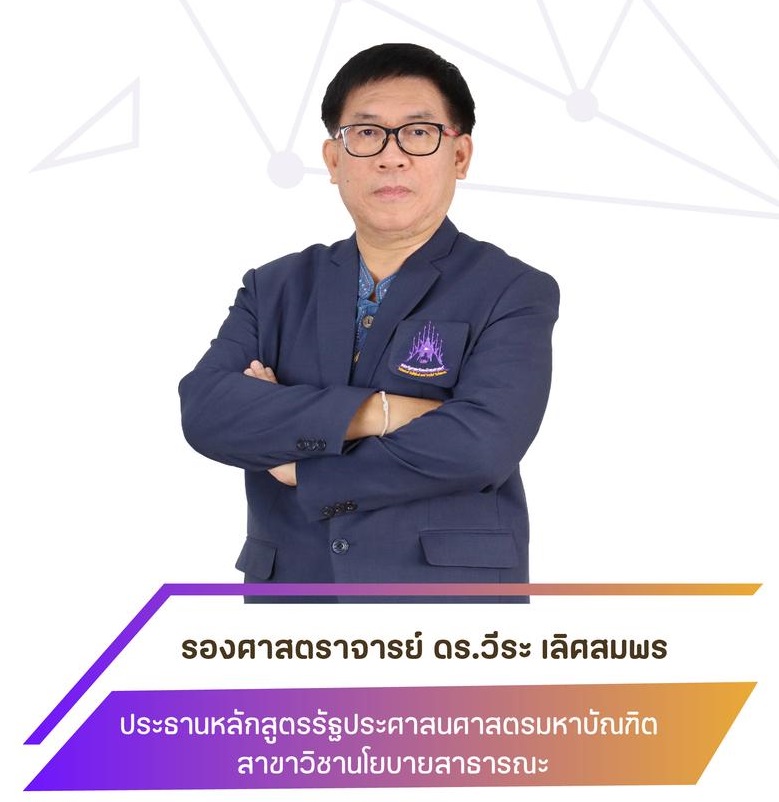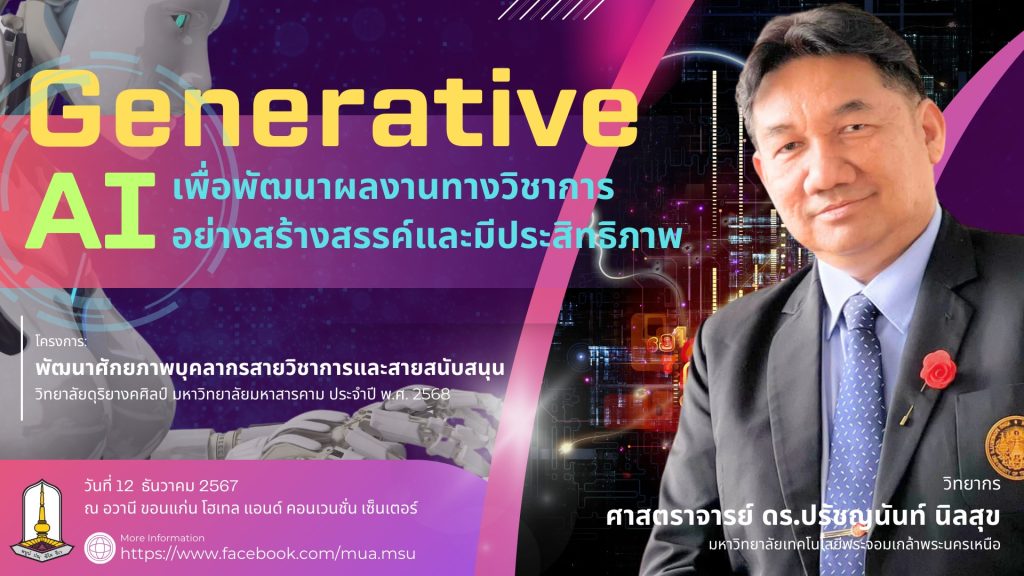ขอแสดงความยินดีกับมหาบัณฑิตและดุษฎีบัณฑิต
ที่จะเข้ารับพระราชทานปริญญาบัตร ประจำปีการศึกษา 2566
ร่วมถ่ายรูปหมู่และแสดงความยินดีกับผู้สำเร็จการศึกษา
วันที่ 16 กุมภาพันธ์ พ.ศ.2568
เรื่องทั้งหมดโดย admin
การพัฒนาทักษะการคิดเชิงนวัดกรรมอย่างสร้างสรรค์ด้วยปัญญาประดิษฐ์
สไลด์บรรยาย
การพัฒนาทักษะการคิดเชิงนวัดกรรมอย่างสร้างสรรค์ด้วยปัญญาประดิษฐ์
สำหรับผู้บริหาร ครูและบุคลากรทางการศึกษา
สถาบันพัฒนาครู คณาจารย์ และบุคลากรทางการศึกษา
วันที่ ๕ กุมภาพันธ์ ๒๕๖๘
https://ict.fte.kmutnb.ac.th/prachyanun/2025/Innovation_Thinking_2025.pdf
Generative AI-Created Digital Influencers to Be University Goodwill Ambassadors
Abstract—This research was aimed at creating and developing digital influencers with generative artificial intelligence to strengthen a university’s image and communicate with a target group, and comparing their use to traditional forms of communication. We conducted the research as an observational study. A literature review was conducted to study the elements of the process of using digital influencers created with generative artificial intelligence through an intelligent platform as university goodwill ambassadors. Research data was collected from a sample group of 150 people. We used a questionnaire to assess the effectiveness of using digital influencers created with generative artificial intelligence through an intelligent platform as university goodwill ambassadors. In the analysis, the use of digital influencers created with generative artificial intelligence through an intelligent platform was compared with regular communication by using the paired t-test statistic. A total of 150 participants were included in the study. The results showed that most of them were female (n = 87; 58 percent), aged 15–25 years (n = 106, 70.67 percent) and students (n = 99, 66 percent); 23 persons were university personnel (15.33 percent) and 28 persons were members of the general public (18.67 percent). From the results of the evaluation of the quality of using digital influencers created with artificial intelligence through an intelligent platform as university goodwill ambassadors, it was found that digital influencers created with artificial intelligence and used through an intelligent platform as university goodwill ambassadors could represent the university, and provide public relations and support for university activities. They could promote relationships between the university and third parties. As a result, communication within the organization became convenient and fast. It was even found to be more modern compared to traditional forms of communication, with statistical significance. Artificial intelligence is effective in improving communication; organizations can provide accurate information immediately and reduce the workloads of personnel. Artificial intelligence can also analyze insights from user conversations. This university can use this information to improve communication to better meet the needs of the target audience.
Keywords—digital influencers, generative artificial intelligence, intelligent platform, university goodwill ambassador
Vipusit Piankarnka, Prachyanun Nilsook, and Panita Wannapiroon,
“Generative AI-Created Digital Influencers to Be University Goodwill Ambassadors,” International Journal of Information and Education Technology, vol. 15, no. 1, pp. 106-116, 2025.
https://doi.org/10.18178/ijiet.2025.15.1.2223
Simulation game-based learning for cognitive apprenticeship development: a focus on processing speed. Cogent Education
Abstract
Processing speed is a critical component of cognitive apprenticeship, which is essential for developing cognitive skills for high-pressure environments. This study highlighted the limitations of traditional teaching methods in fostering rapid decision-making skills and proposed a simulation game-based learning (SGBL) model as an innovative instructional approach. It aimed to (1) develop a targeted SGBL model, (2) assess its effectiveness in enhancing cognitive apprenticeship and processing speed and (3) evaluate student satisfaction. The methodology was divided into three phases: a primary study to identify student needs, system design and development, and implementation. The SGBL model included theoretical and practical sessions, encompassing real-world scenario-based games for practicing life-saving skills. The study involved 73 undergraduate students, split into two experimental groups, and utilised a learning achievement test and a satisfaction questionnaire as research instruments. The findings revealed significant improvements in processing speed and learning outcomes (p < .01). Students expressed high levels of satisfaction, indicating the effectiveness and potential applicability of the model in other fields. Future implications include expanding SGBL with AR/VR and multiplayer functions to enhance engagement and applicability.
Keywords:
Sounthornwiboon, P., Sriprasertpap, K., & Nilsook, P. (2025).
Simulation game-based learning for cognitive apprenticeship development: a focus on processing speed. Cogent Education, 12(1).
https://doi.org/10.1080/2331186X.2024.2449280
เส้นทางสู่ศาสตราจารย์
เอกสารสัมภาษณ์ “เส้นทางสู่ศาสตราจารย์”
ของศาสตราจารย์ ดร.ปรัชญนันท์ นิลสุข
สัมภาษณ์โดย
รองศาสตราจารย์ ดร.วีระ เลิศสมพร
ประธานหลักสูตรรัฐประศาสนศาสตรมหาบัณฑิต
สาขาวิชานโยบายสาธาณะ
คณะรัฐศาสตร์และสังคมศาสตร์
มหาวิทยาลัยพะเยา
ดร.วีระ มีจิตศรัทธาที่จะรวบรวม “เส้นทางสู่ศาสตราจารย์”
ของบรรดาศาสตราจารย์ทั่วประเทศ เพื่อประโยชน์แก่สาธารณะชน
ได้ส่งข้อสรุปคำสัมภาษณ์เพื่อเผยแพร่
ช่วยตอบคำถามที่ถามมาบ่อย ๆ ได้เป็นอย่างดี เชิญแวะไปอ่านได้ :
http://www.prachyanun.com/2024/Weera_Prof_2564.pdf
https://ict.fte.kmutnb.ac.th/prachyanun/2024/Weera_Prof_2564.pdf

ส.ค.ส.2568

สวัสดีปีใหม่ พ.ศ.2568
Happy New Year 2025
ทุกเวลาวันดีมีความสุข ทุกวันทุกข์ห่างหายมลายสูญ
ทุกเดือนรุ่งเรืองศรีมีเพิ่มพูน ทุกปีคูณชีวีมีสุขใจ
ขอคุณพระรักษาเทวาคุ้ม ขอหมดกลุ้มมลพิษจิตแจ่มใส
ขอลาภยศงดงามได้ตามใจ ขอปีใหม่สนุกสนามสำราญเทอญ
ด้วยรักและระลึกถึง
ปรัชญนันท์ นิลสุข
http://www.prachyanun.com
เธอยัง
ง่ายเกินไป
The Effectiveness of Flipped Classroom in English Language Learning: A Meta-Analysis
Abstract
The Flipped Classroom (FC) model, a teaching method used in various educational settings, including language learning, aims to improve student engagement and understanding. Its application in English language learning involves restructuring traditional teaching and learning methods. This study was meticulously designed to assess FC’s effectiveness in improving English language proficiency. A comprehensive meta-analysis was conducted on research articles from January 2021 to November 2023, retrieved from ERIC and the Scopus Index. After a rigorous independent review and data extraction process by two reviewers, nine studies with a total of 705 participants were included. The methodological quality of the selected articles was evaluated using the Fail-Safe N for Publication Bias Assessment. The results, which showed that FC was more effective than conventional methods in enhancing overall English language proficiency (SMD=0.85, 95% CI -0.57 to 1.12, P<.001, I2=65.45%), knowledge (SMD=0.84, 95% CI -0.55 to 1.12, P<.001, I2=49.49%), and skills (SMD=0.70, 95% CI -0.30 to 1.11, P<.01, I2=75.97%), instill confidence in the robustness of our findings. These results suggest that FC has the potential to significantly improve English language acquisition outcomes. However, further research with larger sample sizes is needed to confirm and strengthen these results.
Keywords: flipped learning, flipped classroom, teaching english, english educational, meta-analysis
Thada Jantakoon, Kitsadaporn Jantakun, Thiti Jantakun, Atjana Noibuddee, Rungfa Pasmala, Panita Wannapiroon, Prachyanun Nilsook (2025) The Effectiveness of Flipped Classroom in English Language Learning: A Meta-Analysis. World Journal of English Language Vol. 15, No. 3; 2025, pp. 50-64.
https://doi.org/10.5430/wjel.v15n3p50
สไลด์บรรยาย Using AI for Research
สไลด์บรรยาย “Generative AI เพื่อพัฒนาผลงานทางวิชาการอย่างสร้างสรรค์และมีประสิทธิภาพ”ณ อวานี ขอนแก่น โฮเทล แอนด์ คอนเวนชั่น เซ็นเตอร์ จัดโดย วิทยาลัยดุริยางคศิลป์ มหาวิทยาลัยมหาสารคาม 12 ธันวาคม 2567
https://ict.fte.kmutnb.ac.th/prachyanun/ppt/AI_Tools_for_Research_Version2.pdf

